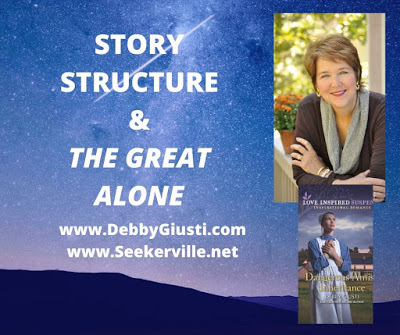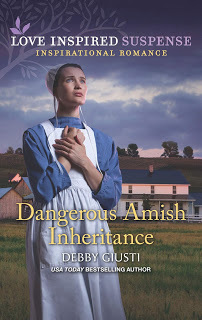Story Structure & The Great Alone
 By Debby Giusti
By Debby GiustiA writer writes, right?
She also reads.
The Great Alone, by Kristin Hannah, was my local book club’s selection last month. The story hooked me from the get-go and wouldn't let up until I had plowed through 545 pages of what The Washington Post deemed “An epic story.”
Other reviews included terms such as “riveting,” “highly cinematic” and “packed with rapturous descriptions.” New York Times bestselling author Kate Moton called it a “novel of love, sacrifice and survival…”
Haunting is how I would describe the story, sad at times, chilling at others. There were moments when I wanted to close the book and shut out the people who had wormed their way into my heart, especially the young teen protagonist.
This isn’t a review, and I don’t want to spoil the story for anyone who plans to read it. Instead, I wanted to share my appreciation for the hard work and attention to detail that went into crafting this story. Kristin Hannah is an amazingly talented writer, and her New York Times bestseller deserves the many accolades it has received since its publication by St. Martin’s Griffin in 2018. I also wanted to take a closer look at how Hannah drew me into her Alaskan saga.

Those who study the craft of writing are aware of the various elements that weave together to create a story. Hannah uses them masterfully. Her descriptive prose transported me back to 1974 when the story opens in Lenora—Leni—Albright’s POV. The thirteen-year-old is the only child of Ernt Allbright, a Vietnam Vet and former POW suffering from PTSD and his chain-smoking flower-child wife, Cora, who loves the memory of the husband she married but fears the explosive man who returned home after the war. When Ernt loses a job yet again, he moves his family north to Alaska where they lay claim to a dilapidated cabin and thirty acres of wilderness he inherited from an Army buddy killed in action.
Contemporary stories start in the protagonist’s ordinary world. An inciting incident follows with what Christopher Vogler, in The Hero’s Journey, identifies as a call to adventure. That call propels the lead characters into action. Within the first twenty-five pages, the Allbrights, having traveled from Seattle in their rickety Volkswagen bus, arrive at the Kenai Peninsula and the town of Kaneq, Alaska.
What they find is not the pristine homestead they had imagined, but a dirty hovel in the wild. The last of the family’s money has been spent on their trek north. Without the resources to return to the lower 48, they have no recourse but to remain in Alaska. James Scott Bell, in Writing From the Middle, would call this the first pillar in the story’s structure from which there is no turning back.

Film director and producer Alfred Hitchcock used ticking time bombs to increase his audiences’ apprehension. Employing that same technique, Hannah continually reminds the reader of the passing summer and the preparations that must be made if the family is to survive throughout the winter.
Friends and mentors as well as enemies are introduced. Hannah creates engaging secondary characters in the eclectic community of Kaneq, many of whom reach out to the newcomers. The setting plays an important role as a hostile antagonist in the dark of winter and a fickle flirt that brings a short-lived reprieve of sunshine in the few weeks of summer.
Early on, the lead characters’ goals, motivation and conflicts are introduced. Screenwriting consultant Michael Hauge says the external goal must be concrete and not an abstract desire, such as wanting to be loved. Taking the necessary steps to stay alive through the winter is an ongoing goal for the Allbright family. Leni's desire to study photography and capture the world around her with her camera becomes one of her goals.

Each of the main characters has an internal conflict—a wound from the past or a flaw that prevents them from living authentic lives. Often they wear a mask to hide their wounds, or flaws, from others and sometimes even from themselves.
Complications continue to mount for the family and our young protagonist. The reader hardly has time to catch a breath before another problem surfaces. The danger is unrelenting and comes from a number of sources. The father with his volatile mood swings puts even the reader on edge. The harsh environment is always a concern, and the family’s fragile situation is compounded by their isolation and the ever-changing weather.
Any writer who worries about piling too much on his character’s shoulders needs to read The Great Alone. Hannah never stops adding hardships and upping the family’s struggle. With each new dilemma, I was pulled deeper into the story.
Two-thirds of the way into the book, Hannah introduces a huge turning point—what James Scott Bell would call the second pillar—that changes the direction of the story. The characters are caught in this new unexpected twist from which there is no escape. The pace intensifies with a mix of bad choices that ratchets up the tension.

So as not to reveal too much, I’ll merely add that there is a romance and a heartbreaking black moment that made me believe the love interests would never come together again. As expected, Hannah provided an exciting climax and a poignant resolution. At the end of the story, the protagonist has changed and grown. She’s overcome the past and has survived.
I am always excited to read a book that pulls me totally into the story. Kristin Hannah’s The Great Alone did exactly that.
Here's a quick review of the writing structure found in the stories we love to read—and write—including The Great Alone.
_Starts in the protagonist’s ordinary world. _Inciting Incident _Lead characters’ GMC, including internal conflict _Call to adventure _Hero accepts the call and passes through the first pillar _Introduction of friends, mentors and enemies _Escalating tension _The second pillar of no return _Black Moment _Climax _Resolution
What stories have you read recently that grabbed you and wouldn’t let go. As a writer, do you analyze the books you read? Is it easy to identify the various structural elements in someone else’s story? What additional structure points do you include in your own stories or find in the stories you read?
Let’s discuss story and the books we love. Leave a comment to be entered in a drawing for my April release, Dangerous Amish Inheritance.
Happy writing! Happy reading!
Wishing you abundant blessings,Debby Giustiwww.DebbyGiusti.com

Dangerous Amish Inheritance
By Debby Giusti
“Move off the mountain. No one wants you here.”
Can this Amish widow survive her dangerous stalker?
Someone wants Ruthie Eicher off Amish Mountain…enough to terrorize the widow and her boys. Now Ruthie must rely on her former sweetheart, Noah Schlabach—the secret father of her eldest son—as they figure out why. But Noah has turned his back on love and the Amish way of life. Can he shield Ruthie…without breaking her heart again?
Pre-order HERE!
Published on February 18, 2020 21:00
date newest »
newest »
 newest »
newest »
message 1:
by
Debby
(new)
Feb 19, 2020 10:41AM
 This book is in my wish list.
This book is in my wish list.
reply
|
flag



